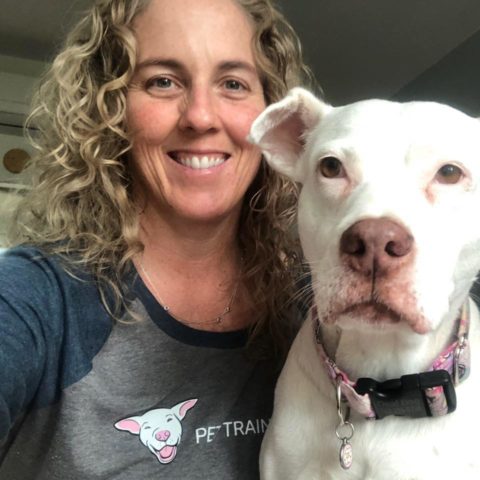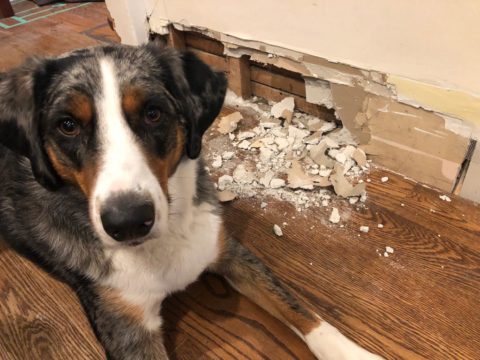Signs of Separation Anxiety in Dogs

If you think your dog might be displaying signs of separation anxiety, what is the very first thing you should do?
The signs of separation anxiety in dogs are not always easily discernable. If you think your dog might be displaying signs of separation anxiety, or if you’re worried that your dog is actually suffering from separation anxiety, the first thing that you want to do is make an appointment with your veterinarian. You should do a vet check to rule out any possible medical reasons for the behaviors (excessive barking, urinating, defecating, etc) that you are seeing.
When you go to the vet, you’ll want to let your veterinarian know how long the behavior has been going on and when it happens. You might even want to chat with your vet about the possibility of medication for your canine. Sometimes people are really worried about anxiety medication, looking to try everything else prior to exploring meds as an option. However, with respect to separation anxiety in dogs, there are some instances where medication is appropriate in combination with behavior modification.
With meds, we are never looking to change the dog’s personality or to completely sedate them, but to allow them to relax enough so that potentially they could work on some behavior modification. Again, having that conversation with your vet is an important piece of the puzzle.
Who can decide if a dog actually has separation anxiety?
If your pup is having trouble being left alone, and displaying perhaps other signs of separation anxiety in dogs, that is actually something that a veterinarian would need to diagnose.
How do you know if a dog has separation anxiety, or might be suffering from something else like isolation distress?
If you’re worried about your dog having separation anxiety, after you’ve done a vet check, then you want to parse out whether or not you might truly be talking about separation anxiety or the more common type of anxiety known as isolation distress.
Separation anxiety is a big umbrella term for this behavior problem. But true separation anxiety, where a dog is experiencing something similar to a panic attack, is fortunately, rarer. True dog separation anxiety is when the canine is only comfortable with one specific person. From a management perspective, that is a really difficult situation. With isolation distress, we’re talking about a dog who’s able to relax as long as there is any human present. Again, from the management side of things, this makes it a little bit easier to work on suspending absences while addressing the problem, or the underlying issue of the anxiety the dog is experiencing.
What are some signs that your dog might have separation anxiety?
Possible behaviors associated with separation anxiety in dogs include (not a complete list):
- barking, howling, whining, eliminating in the house, chewing inappropriate objects when alone, panting, pacing, crate escape attempts, confinement escape attempts (from x-pen or a room), drooling/wet muzzle
Often online you might see questions about a dog who’s eliminating inside and people wonder if it’s a house-training issue. People might be talking about their dog barking on and on for a long period of time when home alone and folks are asking how to stop the behavior. Or, someone might be asking for online help about their dog’s destructive behavior. However, many times people might not put together the pieces that all of these behaviors may amount to a dog actually suffering from separation anxiety.
If a dog is eliminating or vocalizing, or being destructive, or even pacing and panting, we want to first address the underlying cause or reason for the behavior. This is the key before thinking about trying to stop or reduce the behaviors. Even more important would be to figure out why the behavior is occurring in the first place. If it’s a result of the dog suffering from separation anxiety, then you would want to address the anxiety and try to help the dog feel more relaxed and calm.
If a dog is showing signs of separation anxiety should the pet parents watch remotely to see what is going on in their absence?
Yes, one way to take a good look at what’s going on with your dog is to watch what’s happening remotely. If you don’t have a camera you could do a FaceTime to Facetime with your smartphone and another device like a laptop or an iPad. You could also do that same setup with a Zoom to Zoom or Skype to Skype meeting between your smartphone and another device.
What you would want to do is set up your device in the house in a place where it’s safe from your dog. Perhaps leave it on a counter where you can see what’s going on. If you anticipate that your dog is going to go right to the door when you depart, you would want to set it up so that you have a view of the doorway. Ideally, you’d have a view of the dog coming to the door. You also would want to set up this observation at a time when you can come back. If you’re leaving to go to work all day, that would not necessarily be the optimal time to look in on your dog. If the dog is suffering and is vocalizing or being destructive, you’d want to be able to come back to relieve that anxiety asap.
Are some signs of separation anxiety in dogs more significant?
Sometimes people will say, “Well, my dog is only barking.” Or “My dog is only pacing and doing a lot of panting.” Or “I come home and his muzzle is wet like he’s been drooling all day, but he’s not destructive.”
What you want to recognize is that any type of behaviors that are displayed as a result of a dog having anxiety are still things that we would want to address. Even if the dog hasn’t reached the point where they’re eating the doorframe and thus escaping from the home that doesn’t necessarily mean that the separation anxiety is any less of a problem for that dog.
Just like with people, long term chronic stress can produce both physical as well as psychological issues. Addressing the underlying reason for the behavior, in this case, separation anxiety, is equally important.
Whether or not the separation anxiety is demonstrated with behaviors that are hugely problematic or seemingly more benign, stress is stress, and you still want to resolve the reason for the behaviors and try to help get the dog some help and relief.
What do pet parents do if they want to stop the behaviors around separation anxiety?
As I’ve mentioned above, if your dog is showing signs of separation anxiety, what we really want to do is address the underlying cause of the separation anxiety in the dog and use only positive reinforcement. The behaviors frequently are a symptom of the underlying stress. If your dog is fearful, anxious or stressed due to separation anxiety or isolation distress then you want to address that anxiety. You want to help him feel more relaxed, calm, and comfortable when he doesn’t have access to a person. Trying to stop or decrease the behavior doesn’t get at the root of the problem.
Let’s say a dog is being destructive, and someone decides to put the dog in a crate. While the dog isn’t able to chew up the couch while crated, he may decide to try to break out of the crate, he might turn to self-injurious behaviors, or he might begin to exhibit other types of behavioral problems. Maybe he’ll eliminate or maybe he could hurt himself trying to escape from the crate. Just avoiding the destruction hasn’t determined the reason for the destruction.
In the case of separation anxiety in dogs, if the behavioral problems are a result of an underlying anxiety issue, then you need to address the anxiety. Once the anxiety is appropriately resolved, typically through a desensitization protocol, subsequent problem behaviors or behaviors that are problems as a result of the anxiety go away, too.
Separation Anxiety in Dogs Series Episode 3 – Signs of Separation Anxiety in Dogs
Get relief from the desolation of your dog’s separation anxiety.
 Have you been thwarted by previous training attempts? You need a highly-trained specialist—an expert who devotes her days to resolving dog desolation distress.
Have you been thwarted by previous training attempts? You need a highly-trained specialist—an expert who devotes her days to resolving dog desolation distress.
I offer a distinctively successful approach to separation anxiety issues with daily guidance and extensive encouragement. If you and your dog are suffering from your dog’s separation anxiety, sign up for my Separation Anxiety Program. I’ll help dissolve your despair.


